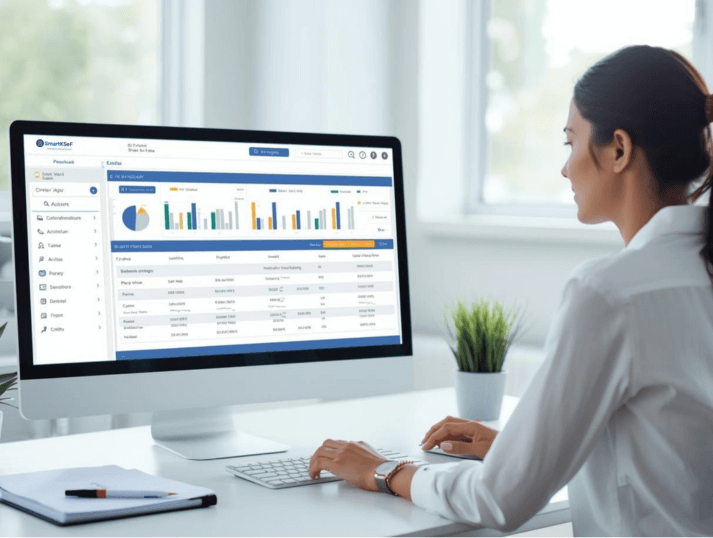As experts at Exorigo-Upos, we work daily with companies – particularly in the retail sector – supporting their preparations for the National e-Invoicing System (KSeF). We have been responsible for assisting in the implementation of e-invoicing solutions for clients such as Empik, Auchan and Credit Agricole EFL Leasing.
One of the topics most frequently raised in these discussions is the uncertainty surrounding how to act in various scenarios – often those beyond one’s direct control.
KSeF is not merely a technological platform; it represents a fundamental shift in business processes, requiring an understanding of situations that extend beyond traditional invoicing routines. The key to a smooth transition lies in recognising which operating mode a company may – or must – use at any given time.
This comprehensive guide provides an in-depth explanation of each invoicing mode under KSeF, outlining their legal and tax implications and highlighting practical considerations to ensure business continuity and full regulatory compliance.
Primary Scenario – Online Mode
The online mode, defined in Article 106gb of the VAT Act, is the default and principal operating model within the KSeF ecosystem.
How does it work?
- The seller’s financial-accounting system generates an invoice in the XML format compliant with the FA(3) schema.
- The invoice is transmitted to the central KSeF database.
- KSeF performs a technical validation of the document and, upon successful verification, assigns it a unique 21-character KSeF identification number.
- From that moment, the invoice is deemed issued and delivered to the buyer (in B2B transactions).
Every visualisation of such an invoice (e.g. a PDF printout) must include a single online QR code and the KSeF number.
This code directly links to the invoice in the government system, allowing for instant verification of its authenticity.
Who is it for?
This mode is ideal for companies whose invoicing process does not require the immediate handover of the document to the customer – for example, B2B relationships based on contracts where invoices are sent after service delivery, goods dispatch, or within regular billing cycles.
When Time Matters – “Transaction Confirmation”
What happens if KSeF is available but responds slowly, and a customer at the checkout expects a document immediately?
The Ministry of Finance has provided practical guidance for such situations.
What is a “Transaction Confirmation”?
This is a provisional document, not a VAT invoice, containing only basic information (seller, buyer, transaction value) and omitting tax details such as VAT rates or amounts.
Its purpose is to:
- Confirm to the buyer that the transaction has been registered by the seller.
- Provide the buyer with two offline QR codes, enabling them later to locate and verify the structured invoice within KSeF.
This solution acts as a bridge, allowing seamless customer service at the point of sale while preserving the logic of KSeF – whereby a legitimate invoice exists only once the system assigns its identification number.
It is important to note that a “Transaction Confirmation” does not replace a VAT invoice when the buyer does not have access to KSeF (e.g. a consumer or foreign entity). In such cases, the seller must issue a VAT invoice separately.
Therefore, this option is practical mainly for B2B transactions, while other customers require a final sales document.
Seller’s Informed Choice – Offline24 Mode
Article 106nda of the VAT Act provides flexibility through the Offline24 mode, allowing a taxpayer to issue and deliver an invoice outside KSeF, with the obligation to submit it later.
Key rules:
- The seller may generate the invoice visualisation immediately, which must contain two offline QR codes.
- The invoice must be transmitted to KSeF no later than the end of the next working day after issuance. Missing this deadline may result in penalties.
Key risk:
A B2B buyer who receives a printout of such an invoice cannot deduct VAT until the invoice has been registered in KSeF and made available to them through the system.
This can easily lead to misunderstandings if the buyer is unaware of the mode under which the document was issued.
When the System Fails – Emergency Modes
What should be done when the issue lies not with your company, but with KSeF itself?
The VAT Act specifies clear procedures for officially announced system downtimes.
Important: The emergency mode may only be used when the Ministry of Finance officially announces it (e.g. via the Public Information Bulletin). Temporary local internet outages do not justify switching to this mode.ary loc
Three states are defined:
- KSeF Unavailability (Art. 106nh) – typically a scheduled maintenance break.
- Action: Issue invoices with two offline QR codes.
- Impact on B2B buyers: Same as in Offline24 – no VAT deduction until the invoice is registered in KSeF.
- Submission deadline: The next working day after system restoration.
- KSeF Failure (Art. 106nf) – an unplanned system malfunction.
- Action: Issue invoices with two offline QR codes.
- Impact on B2B buyers: This is the key exception – such an invoice is deemed fully valid, and the buyer may deduct VAT.
- Submission deadline: Within 7 days of the system’s recovery.
- Total KSeF Outage (Art. 106ng) – a critical failure rendering the government systems unavailable nationwide.
- Action: Temporary reversion to traditional invoicing methods (paper or electronic forms such as PDF).
Seller’s Responsibility: Clarity Above All
A B2B buyer may receive documents that look identical (e.g. printouts with two QR codes) yet carry entirely different legal and tax statuses.
Issuing an invoice in Offline24 or during KSeF unavailability risks the buyer recording it incorrectly.
In KSeF’s API metadata, the field invoicingMode specifies whether a document was issued in Online or Offline mode.
However, neither the printout nor the data retrieved from KSeF reveal the precise issuing context.
For transparency and to protect business relationships, we recommend explicitly stating the invoicing mode on the invoice visualisation, for example:
- “VAT Invoice No … issued in Online Mode (Art. 106gb)”
- “Transaction Confirmation No …”
- “VAT Invoice No … issued in Offline24 Mode (Art. 106nda)”
- “VAT Invoice No … issued in Offline Mode – KSeF Unavailability (Art. 106nh)”
- “VAT Invoice No … issued in Offline Mode – KSeF Failure (Art. 106nf)”
Such annotations eliminate any doubt on the recipient’s side.
Managing the Complexity: System Support in SmartKSeF
Manually monitoring Ministry of Finance announcements, tracking submission deadlines, and managing QR-code generation is complex and error-prone. This process requires automation.
That’s where an advanced e-invoicing solution such as SmartKSeF by Exorigo-Upos becomes indispensable.
It has been designed to relieve companies of this operational burden:
- Automatic KSeF status monitoring – SmartKSeF continuously checks the official KSeF status and informs your sales system which invoicing mode applies.
- Intelligent submission management – In case of connectivity loss or KSeF downtime, SmartKSeF queues invoices securely and automatically transmits them once the system is back online.
- Accurate data generation – Regardless of the scenario, SmartKSeF provides your system with the correct data – whether it’s the KSeF number and online QR code, or two offline QR codes for a Transaction Confirmation or emergency invoice.
- Full audit trail and transparency – Every operation is logged, providing a complete record of communication with KSeF and the status of each invoice. During a tax audit, all details explaining the chosen invoicing mode are readily available.
Implementing KSeF need not be complicated.
With the right tool – SmartKSeF – your company can focus on its core business while being confident that its invoicing processes remain secure, automated, and fully compliant with the evolving legal framework.
Want to learn more and prepare your organisation for KSeF? Contact the Exorigo-Upos experts to explore how SmartKSeF can support your business: kontakt@exorigo-upos.pl
More information: https://www.exorigo-upos.com/smartksef/


